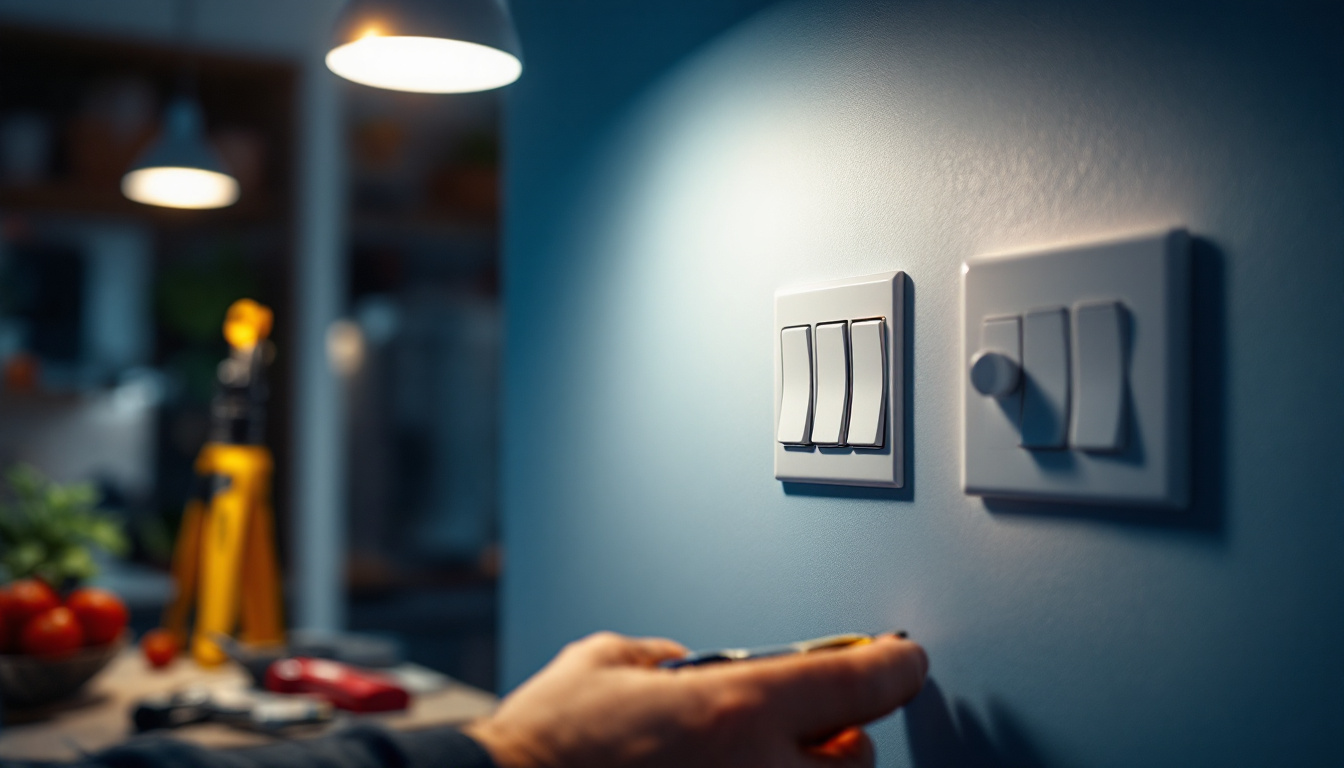
three-way switches are essential components in residential and commercial lighting systems, allowing for convenient control of lighting from multiple locations. As a lighting contractor, understanding the intricacies of three-way switch installations can enhance the efficiency of your projects and improve client satisfaction. This article delves into proven methods for successfully working with three-way switches, providing insights that can elevate your expertise in the field.
Before diving into installation techniques, it’s crucial to grasp the fundamental concepts behind three-way switches. Unlike standard single-pole switches, which control a light from one location, three-way switches enable control from two different points. This functionality is particularly useful in hallways, staircases, and large rooms where access to lighting controls from multiple locations is desired. The convenience of three-way switches not only enhances the usability of spaces but also contributes to improved safety, as it allows for easy access to lighting in potentially hazardous areas, such as staircases or dark hallways.
A typical three-way switch setup consists of two three-way switches and a light fixture. Each switch has three terminals: one common terminal and two traveler terminals. The common terminal connects to the power source or the light fixture, while the traveler terminals connect to the second switch. Understanding these components is vital for successful installations and troubleshooting. Additionally, it’s important to note that three-way switches can come in various styles, including toggle, rocker, and smart switches, each offering unique features such as dimming capabilities or remote control via smartphone apps, further enhancing the functionality of your lighting system.
Wiring a three-way switch can be more complex than a standard switch. The two switches must be wired correctly to allow the current to flow through the desired path. Typically, a 14/2 or 12/2 gauge wire is used, depending on the circuit’s amperage requirements. The black wire usually serves as the hot wire, the white wire as the neutral, and the bare or green wire as the ground. Familiarity with these wiring conventions is essential for any lighting contractor. It’s also critical to ensure that power is turned off at the circuit breaker before beginning any wiring work to prevent electrical shock. Moreover, understanding the layout of your home’s electrical system can aid in determining the most efficient routing for wires, minimizing the need for extensive drywall repairs or additional junction boxes.
Proper installation techniques are critical for ensuring functionality and safety. Here are some proven methods that can streamline the installation process and minimize errors.
Before beginning any installation, a detailed plan should be developed. This involves determining the optimal locations for the switches and the light fixture. Consider factors such as accessibility, aesthetics, and the existing wiring layout. A well-thought-out plan can prevent unnecessary complications during the installation process. Additionally, it is beneficial to visualize the final setup by sketching a diagram or using design software. This can help identify potential issues early on, such as obstructions or inadequate spacing, allowing for adjustments before any physical work begins. Furthermore, discussing the layout with other household members can provide insights into preferences and usage patterns, ensuring that the final installation meets everyone’s needs.
Having the appropriate tools on hand can significantly improve the efficiency of the installation. Essential tools include a voltage tester, wire strippers, screwdrivers, and a drill. Additionally, using a fish tape can help in guiding wires through walls or ceilings, especially in older buildings where access may be limited. Investing in quality tools not only speeds up the process but also enhances safety. It’s also wise to keep a toolbox organized with all necessary items easily accessible, which can save time during installation. Moreover, having a good work light can illuminate dark spaces, ensuring that every connection is made accurately and safely. Remember, using the right tool for the job can prevent damage to components and reduce the risk of accidents.
1. **Turn Off Power**: Safety should always be the first priority. Ensure that the power to the circuit is turned off at the breaker box before starting any work.
2. **Install the First Switch**: Begin by connecting the common terminal of the first switch to the power source. Attach the traveler wires to the traveler terminals.
3. **Run the Cable to the Second Switch**: Use a suitable gauge wire to connect the first switch to the second switch. Ensure that the traveler wires are correctly connected to the corresponding terminals.
4. **Connect the Light Fixture**: At the light fixture, connect the common terminal of the second switch to the fixture. The neutral wire should be connected to the light fixture’s neutral terminal.
5. **Ground Connections**: Ensure that all ground wires are securely connected to each switch and the light fixture. This is crucial for safety and compliance with electrical codes.
6. **Test the Installation**: Once everything is connected, turn the power back on and test the switches to ensure they function correctly. If the light does not operate as expected, double-check the wiring connections. Additionally, it can be helpful to label the wires during installation, especially if multiple circuits are involved. This practice not only aids in troubleshooting but also simplifies any future modifications or repairs.
Even with careful planning and execution, issues can arise during or after the installation of three-way switches. Being able to troubleshoot these problems efficiently can save time and enhance client satisfaction.
If the switches do not operate the light fixture, the first step is to check the power supply. Ensure that the circuit breaker is on and that there are no blown fuses. If power is present, inspect the wiring connections at both switches and the light fixture for any loose or incorrect connections.
Flickering lights can be a sign of poor connections or faulty switches. Inspect all wiring for tight connections and ensure that the switches are functioning correctly. If the problem persists, consider replacing the switches, as they may be worn out or damaged.
If the switches operate inconsistently, it could be due to a wiring error. Verify that the traveler wires are connected to the correct terminals on both switches. Additionally, ensure that the switches are compatible with the type of lighting being used, as some LED fixtures may require specific types of switches.
For lighting contractors looking to enhance their skills further, there are advanced techniques that can be employed to optimize three-way switch installations.
With the rise of smart home technology, integrating smart switches into three-way switch setups is becoming increasingly popular. Smart switches allow for remote control and automation of lighting systems, providing added convenience for homeowners. When installing smart switches, it’s essential to follow the manufacturer’s instructions carefully, as the wiring may differ from traditional three-way switches.
In larger spaces, consider using multi-location control systems that allow for the control of a single light fixture from multiple locations, beyond just two switches. These systems often utilize wireless technology, making installation easier and reducing the need for extensive wiring. Familiarity with these systems can set a lighting contractor apart from competitors.
Incorporating energy-efficient lighting solutions, such as LED bulbs, can significantly reduce energy consumption and appeal to environmentally conscious clients. When installing three-way switches with LED fixtures, ensure that the switches are compatible with LED technology to avoid flickering or dimming issues.
Adhering to electrical codes and safety standards is paramount in any lighting installation. Understanding the local regulations regarding three-way switches and general electrical work can prevent legal issues and ensure client safety.
Each region has its own electrical codes that dictate how electrical systems should be installed. Familiarize yourself with these codes to ensure compliance. This may include specific requirements for wire types, switch placements, and grounding practices. Regularly reviewing these codes can keep your work up to date and compliant.
Implementing safety practices during installations can prevent accidents and injuries. Always wear appropriate personal protective equipment (PPE), such as gloves and safety glasses. Additionally, ensure that work areas are well-lit and free from hazards. Educating clients about the importance of electrical safety can also foster trust and professionalism.
Maintaining accurate documentation of installations can be beneficial for both contractors and clients. This includes keeping records of wiring diagrams, switch locations, and any modifications made during the installation. Such documentation can aid in future troubleshooting and serve as a reference for clients when they need to make changes or repairs.
Three-way switches are a fundamental aspect of modern lighting systems, offering convenience and flexibility in controlling lighting from multiple locations. For lighting contractors, mastering the installation and troubleshooting of three-way switches is essential for delivering high-quality service to clients. By employing proven methods, utilizing advanced techniques, and adhering to safety standards, contractors can enhance their skills and build a reputation for excellence in the industry.
As technology continues to evolve, staying informed about the latest trends and innovations in lighting control will further empower contractors to meet the diverse needs of their clients. Embracing these practices not only benefits the contractor but also contributes to the overall safety and satisfaction of the end-user.
Ready to elevate your lighting projects with the expertise you’ve gained on three-way switches? Look no further than LumenWholesale for all your lighting needs. Our extensive selection of spec-grade lighting products ensures you have access to the highest quality switches and lighting solutions. With unbeatable wholesale prices and the convenience of free shipping on bulk orders, you can confidently stock up on the essentials without worrying about hidden fees. Make your next project shine with the perfect blend of quality, affordability, and convenience. Wholesale Lighting at the Best Value is just a click away. Choose LumenWholesale and experience the difference today!

Discover essential tips from top lighting contractors on how an electrical outlet store can help you avoid common issues, ensure safety, and save up to 20% on quality outlets..

Discover the essential guide for lighting contractors with “Illuminating Light Switch: The Ultimate Lighting Contractor Checklist.” This comprehensive article provides expert insights, practical tips, and a step-by-step checklist to ensure flawless lighting installations and client satisfaction.

Discover how solar LED lamp posts are revolutionizing the work of lighting contractors by offering energy efficiency, easy installation, and sustainable solutions.

Discover how lighting contractors are transforming spaces with commercial outdoor ceiling fans.